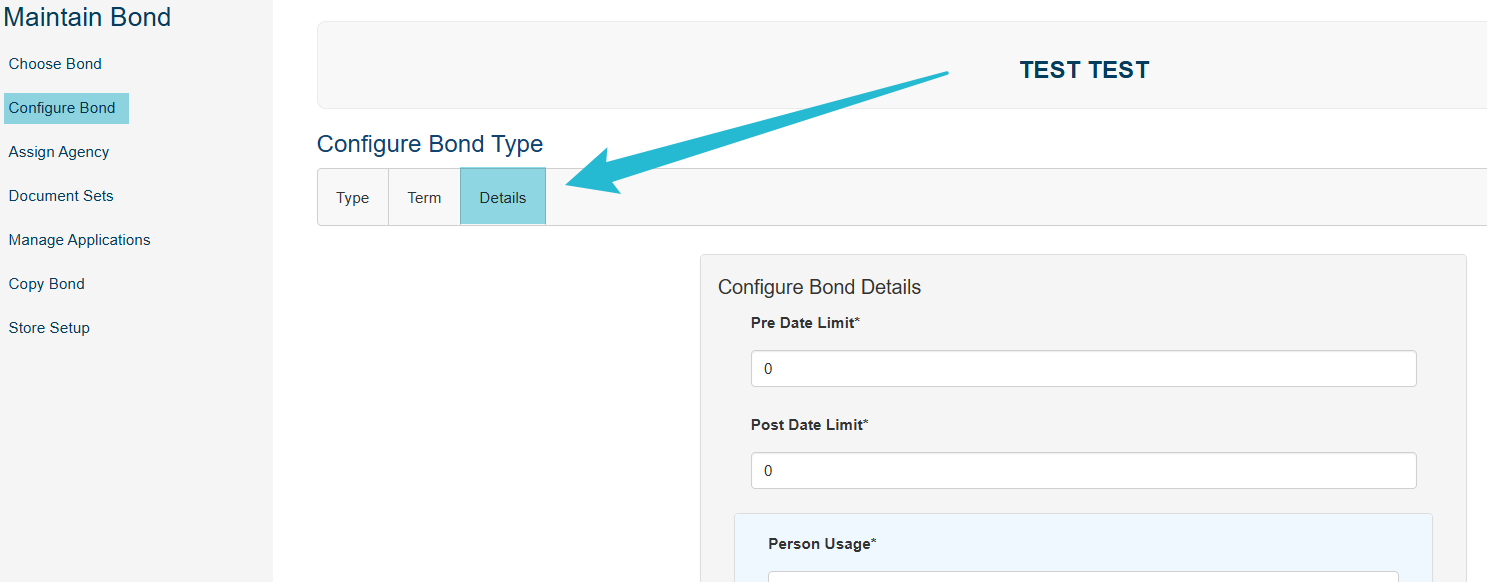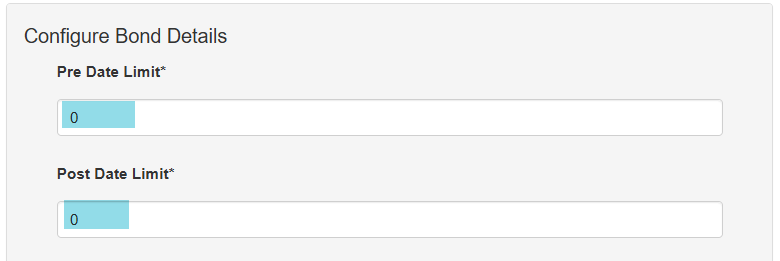Configuring the Details for Maintaining a Bond
Overview for Configuring Bond Details
When maintaining a bond, users must set the basic configuration properties that will establish premium calculation, expiration, billing, and bond specific settings.
The Configure Bond Details page is where bond administrators set additional criteria specific to this bond configuration.
As you input the necessary information, this guide will assist with defining the fields.
Accessing the Billing Type Configurations
Select Maintain Bond/[Choose Bond Configuration]/Configure Bond, then select the Details tab.

Pre-Date Limit
Enter the Pre-Date Limit in the text field available.
The value entered represents the maximum number of days prior to the current date in which a user can set the effective date of the bond during the buy a bond process. This limit will be imposed when manually entering an effective date for the bond.

Post-Date Limit
Enter the Post-Date Limit in the text field available.
The value entered represents the maximum number of days after the current date in which a user can set the effective date of the bond during the buy a bond process. This limit will be imposed when manually entering an effective date for the bond.
Company Usage
NotSet
Setting the Company Usage to NotSet means that the requirement of a company entity on a bond will be determined by the Company question on the bond's configuration application.
Optional
Setting the Company Usage to Optional means that a company can be entered on the bond but it is not required.
Required
Setting the Company Usage to Required means that at least one company must be entered on the bond.
Excluded
Setting the Company Usage to Excluded means that a no company entities can be entered on the bond.
Person Usage
NotSet
Setting the Person Usage to NotSet means that the requirement of a person on a bond will be determined by the Person question on the bond's configuration application.
Optional
Setting the Person Usage to Optional means that a person (or people) can be entered on the bond but they are not required.
Required
Setting the Person Usage to Required means that at least one person must be entered on the bond.
Excluded
Setting the Person Usage to Excluded means that the entry of a person (or people) on a bond is not allowed.
Applicant Usage
NotSet
Setting the Applicant Usage to NotSet means that the preferred applicant designation will be determined by the CommercialDefaultApplicantType and ContractDefaultApplicantType system settings. You can find these system settings located at All > Setup > Settings > System Default
PreferCompany
Setting the Applicant Usage to PreferCompany means that the first company entity will be the default selection in the Applicant drop-down BUT does not prevent the user from changing the selection to a person.
RequireCompany
Setting the Applicant Usage to RequireCompany means that only company entities can be selected set as the bond applicant.
PreferPerson
Setting the Applicant Usage to PreferPerson means that the first person listed in the "People" will be used as the default selection within the Applicant drop-down. This option does not prevent the user from changing the selection to a different person or company.
RequirePerson
Setting the Applicant Usage to RequirePerson means that only people can be selected as the bond's applicant.
Reinsurance Company
Select the Reinsurance Company, if any, from the dropdown displayed. If the bond configuration is covered under a reinsurance treaty, select the appropriate reinsurance company. Otherwise, select "- Make Selection -" (the default value). The reinsurance companies displayed in this dropdown are those that have been predefined in System Tables/Reinsurance Companies.
If a reinsurance company is selected, the names of all reinsurers within that company will appear in the reassign for Approval dropdown on the view bond screen so that the bond may be routed to the appropriate reinsurer's queue for approval if internal underwriter/management authority limits are exceeded.

Bond Title
Enter a title for the new bond in the Bond Title text field. This title will be available for use as a template field on PDFs and may appear on bond documents such as the Power-of-Attorney or invoices, if desired. Choose a name that clearly and fully describes the bond since this is the manner in which an obligee or Applicant may later refer to the bond.
SFAA Code
Find the appropriate SFAA Code for the bond configuration. These codes are pre-configured into the system; however, the bond administrator has the ability to define new codes or maintain codes in the listing in System Tables/SFAA Codes.
Configuration Code
Enter an optional identification number in the Configuration Code text field. This code identifies a specific configuration for the client’s internal uses including reporting and backend system integration.
Bond Configuration Description
Enter an optional description in the Bond Configuration Description field. This will allow carriers to describe the configuration and add pertinent details such as rates, term duration, and any other details that would benefit agents when searching for the bond configuration.
Basic text entries can be made, but additional text formatting and HTML markups can be made as well. This description will be displayed below the PDF Preview after selecting the criteria for a bond configuration when searching for a bond.
After completing all desired fields in the Term and Details tabs, click submit to save the changes.
